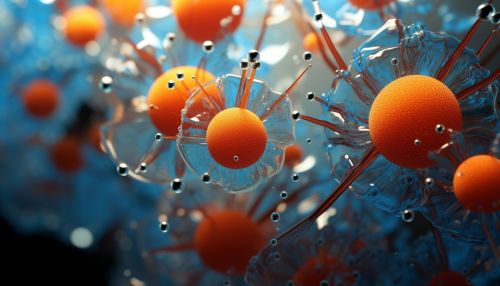Immunoglobulin
Introduction
Immunoglobulin (Ig), also known as antibodies, are large Y-shaped proteins produced by B cells that are used by the immune system to identify and neutralize foreign objects such as bacteria and viruses. The antibody recognizes a unique part of the foreign target, termed an antigen. Each tip of the "Y" of an antibody contains a paratope (a structure analogous to a lock) that is specific for one particular epitope (similarly analogous to a key) on an antigen, allowing these two structures to bind together with precision.


Structure
Immunoglobulins are glycoprotein molecules that are produced by plasma cells (white blood cells). They are made of four polypeptide chains: two identical heavy chains and two identical light chains. Each immunoglobulin has two antigen binding sites. This is a result of its quaternary structure: the overall three-dimensional arrangement of the heavy and light chains results in two identical sites where an antigen can bind to the immunoglobulin.
Classes
There are five classes of immunoglobulins: IgG, IgA, IgM, IgD, and IgE. Each class differs in its biological features, function, concentration in serum, and distribution in the body. IgG is the most common type of antibody found in blood circulation, while IgA is found in mucous, saliva, tears and breast milk. IgM is usually the first antibody produced by the immune system when a new antigen is encountered. IgD is present on the surface of many B cells where it plays a role in B cell activation. IgE is associated with allergic reactions and is found mostly in the lungs, skin, and mucous membranes.
Functions
The primary function of immunoglobulins is to bind to specific foreign particles, such as bacteria, viruses, and fungi, to help protect the body. They can neutralize toxins, bind to viruses to prevent them from entering cells, and coat bacteria to enhance their ingestion by white blood cells. In addition to these functions, each class of immunoglobulins has a unique role in the immune response.
Production and Regulation
The production of immunoglobulins is regulated by a complex network of interactions involving antigens, B cells, and helper T cells. When an antigen enters the body, it can be recognized by specific B cells, which then become activated and differentiate into plasma cells. These plasma cells are the primary producers of antibodies. The production of antibodies is also influenced by helper T cells, which release cytokines that further stimulate the B cells.
Clinical Significance
Immunoglobulins play a crucial role in the body's immune response, and abnormalities in their function or levels can lead to disease. For example, individuals with immunodeficiencies may have a decreased production of immunoglobulins, leading to increased susceptibility to infections. On the other hand, overproduction of certain types of immunoglobulins can lead to allergies and autoimmune diseases. Measurement of specific immunoglobulin levels can aid in the diagnosis and monitoring of various diseases.
